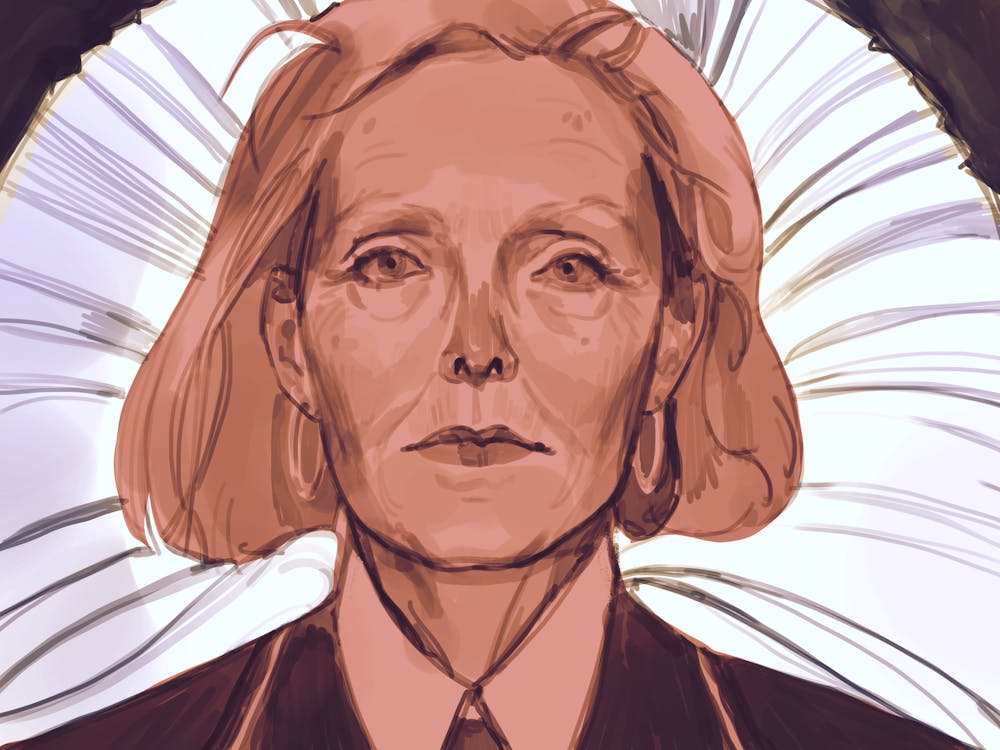Anne Carson’s 23rd publication, “Wrong Norma” meditates, deconstructs, scolds, announces, humors and — most importantly — questions a seemingly disparate cluster of topics. In an unruly, genre-less, collaged collection of text and images water, blood, Flaubert, form, crows, Guantanamo, grief and the Rig Veda gather in a crowd of luminous nouns. Published in February, the work is a fabulous testament to Carson’s persistently radical unboundedness.
In “Flaubert Again,” the sixth of 25 titled pieces, an aimless author is haunted by the “fantasy of a different kind of novel” — a fantasy, she laments, that “all novelists share.”
“‘What would such a form entail?’” this Carson-disguised-as-protagonist asks herself and her readers. Her tentative, skeptical answers are Abolition (not renouncement) and continuity — “a story of nothing and everything at the same time.” The writer and her character realize they are summarizing Flaubert (again) and seem quickly to forget about this objectless desire.
Here, Carson taps readers on the shoulders and whispers a little joke, quiet enough that the punchline isn’t entirely intelligible. On the back cover of “Wrong Norma,” Carson continues her witty exposition in a text that successfully satisfies the impossible literary inclination to redefine the novel: “The pieces are not linked. That’s why I’ve called them wrong.”
Carson causes us to question: is connectedness correctness? Are we (in)correct about (in)correctness? “Wrong night, wrong city, wrong movie, wrong ambulances … wrong Norma Desmond,” Carson opens the titular prose-poem that closes the collection. Perhaps she is (knowingly, could it be?) wrong about the wrongness of her piece, even if her implied definition stands. Despite its author’s claim, “Wrong Norma” is not only thematically coherent but masterful.
The “new novel” is itself a redundancy, a phrase of synonyms, a repetition. Invoking the charge of repetition with difference (and repetition as difference), the text picks up and puts down words in a marvelous, incoherent and delightfully recurrent rhythm.
The cover of the book features a distorted image of a fox — which will find itself reappearing in various moments of the text — in a twisted, warped visual display. In “1=1,” the first piece in the work, the fox appears as a chalk drawing. Over one hundred pages later, in “The Visitors,” it reemerges along with a gathering of unannounced passersby, “trembly” and “breath(ing) with the night” in the home of a quirky, thesaurus-loving narrator.
This narrator-embodying-Carson waxes her synonyms, taken right out of Roget’s thesaurus: “Incongruous (inappropriate, inapt, improper, incompatible, irreconcilable, inconsistent, unusual, warring, strange, alien),” referring simultaneously to the disunion (through meaning) and repetition (through form) of the book within which her piece sits. The fox slinks away, only to reappear several essays later.
“Did I mention my admiration for Éric Rohmer, yes I think so,” Carson and this narrator write together. This is the sixteenth time Rohmer’s name is used in under 30 pages — it appears 14 pages earlier, and 15 pages before that, as well as smattered uncountably between the collection’s named pieces. Here, again, the use of motif reappears, hidden playfully in plain sight under a blanket of so-called wrongness. In Carson’s plotless poems (which appear between most of the collection’s named pieces and look to be pasted and collaged onto the page), she asks again and again: “Do you like the films of Eric Rohmer;” “do you like jam;” “what is your philosophy of time;” “how do you sustain morale during a long project.” She always answers herself differently — “dress dandy,” “this cradle of forehead,” “sorry,” “yes during the night.”
“Some questions don’t warrant a question mark,” Carson writes, in a defensive (and humorous) response. She might be making a linguistic conjecture, or else deconstructing the binary between inquiry and answer. As a translator, poet, performer and visual artist enjoying her fourth decade of acclaim, Carson is qualified for most anything.
She is perhaps instead implying that her asking is an end in-and-of itself, a causation of boundless ideation rather than definitive retorts. There is no right answer, she seems to say, only Wrong Normas. “What can you control?” she asks in “What to Say of the Entirety.” “Wrong question. Can you treat everything as an emergency without losing the reality of time, which continues to drip, laughtear by laughtear (sic)? Where to start?”
There is no “start,” of course — to encapsulate this theory of possibility is Carson’s temporal deconstruction, ever-present across her oeuvre. In a raucous postmodern translation of Alkibiades’s speech from Plato’s Symposium, the homoeroticized Socrates muses on Bob Dylan. A man who looks like Joseph Conrad walks out of an elevator, so the narrator dresses up like Joseph Conrad and walks out of the same elevator, hoping to find himself standing on the other side of the doors. In arguably the most memorable piece in the collection, “Lecture on the History of Skywriting,” the narrator — the sky itself — writes about its own desire to be written on. “For a creature who exists (like myself) outside time, death has no instant,” the sky describes. “I have no instant. I am at all times.”
Where to end? The supposed disjunction — the wrongness of this work — is permeated by Carson’s repetition of subject matter and theme, creating a linkage that creates a refrain, binding the whole work inextricably to itself. Like the water she writes of on the first page of this brilliant book, Carson’s “wrong” text “has a right place to be but this place is in motion, you have to keep finding it, keep having it find you. Your movement sinks into and out of it with each stroke. You can fail it with each stroke. What does that mean, fail it?”
Liliana Greyf is a senior staff writer covering College Hill, Fox Point and the Jewelry District, and Brown's relationship with Providence. She is a sophomore studying Literary Arts and a proponent of most pickled vegetables.





